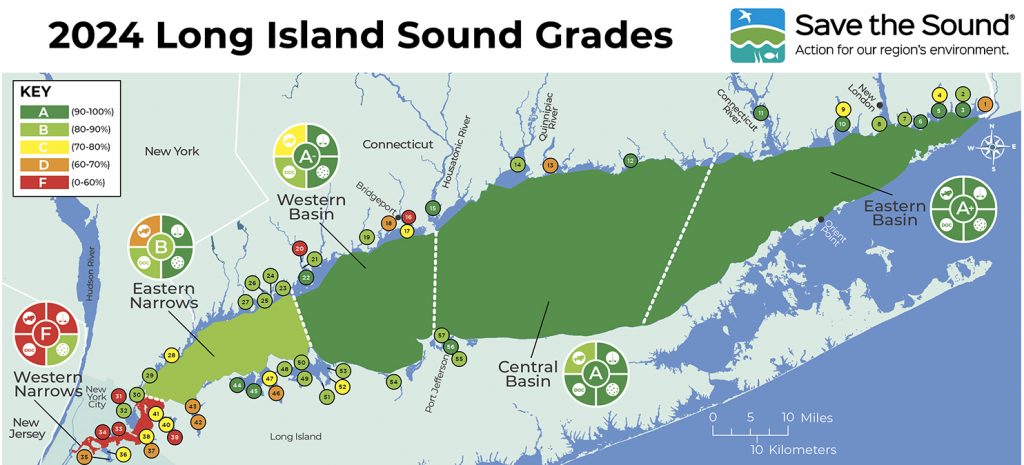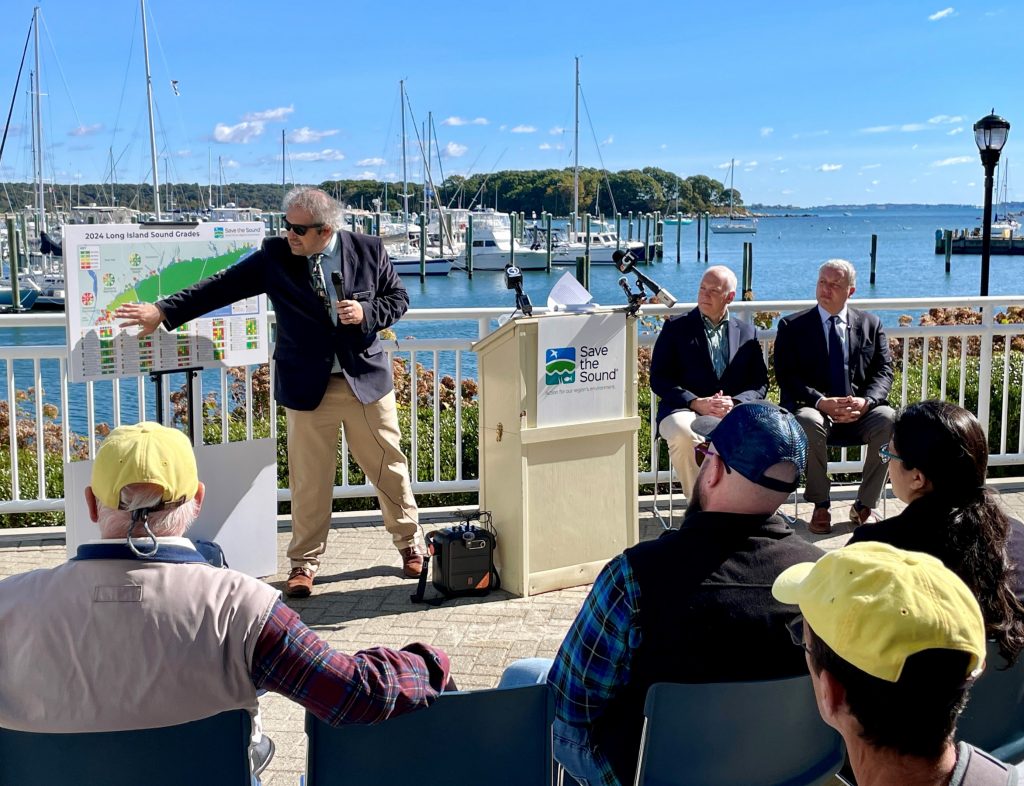Save the Sound 10/10/2024
Nitrogen Pollution Management Leads to Improvement in Open Water Grades; Water Quality in Many Sound Bays Raises Concern
The regional nonprofit environmental organization Save the Sound has released findings of its 2024 Long Island Sound Report Card. The biennial report offers compelling evidence that efforts to reduce the amount of nitrogen released into Long Island Sound continue to be effective in improving water quality.
Download YOUR electronic copy of the 2024 Long Island Sound Report Card here
More than 98 percent of the open waters of Long Island Sound earned a grade of B or higher, which is encouraging news. Even suburban and urban areas closer to New York City showed moderate improvement. The “Eastern Narrows” section of the Sound’s open waters, for example, received an overall grade of B, up from a C in the previous Report Card, and up from a D+ in 2008. This section shows improvement in two important water quality indicators: chlorophyll a and dissolved organic carbon.

In sobering news, however, the waters closest to New York City in the “Western Narrows” continue to receive an F, despite some improvement. Equally concerning, 42 percent of the 57 bays and bay segments along the Sound shoreline earned a C or below, in some cases even when adjacent open waters scored higher – illustrating the need for locally-focused efforts in these waters.
Nitrogen pollution reduction is indeed a cornerstone in efforts to preserve and continue water quality gains in the open waters of the Sound and its numerous bays. Excess nitrogen fuels algae blooms which lower dissolved oxygen, killing fish and other animals in the water. It also contributes to the loss of eelgrass and tidal marshlands and diminishes biodiversity in one of the country’s largest estuaries.
A major source of nitrogen pollution in open waters comes from wastewater of the more than nine million people living in the Sound’s multi-state watershed. In bays, nitrogen in lawn fertilizers, polluted groundwater, and stormwater runoff become more impactful on a local level. What’s more, fossil fuel emissions have added tremendous amounts of nitrogen to the air, which leads to high concentrations of nitrogen in precipitation falling directly into the Sound. This runoff and polluted precipitation are having a greater impact as storms increase in frequency and severity due to climate change.
David Ansel, vice president of water protection for Save the Sound, commented, “It’s clear that past investment in nitrogen pollution reduction from wastewater infrastructure is linked to improving the open waters of Long Island Sound. Now, our challenge is to find the political will to extend and expand this investment. If we do not act, climate change impacts – including rising water temperatures and changes in storm frequency and intensity in the Sound – threaten to erase our hard-won gains. Already, lingering poor water quality in area bays and open waters near population centers signals that more must be done.”

A range of options for upgrading outdated wastewater infrastructure exist, including ambitious plans in motion for the West End Treatment Plant in Bridgeport, CT; the repair of miles of underground sewer pipes committed to by coastal municipalities in Westchester County; and the grant programs that enable home and business owners on Long Island to replace hundreds of thousands of septic systems with new nitrogen-reducing systems. Residents of Suffolk County will vote in November on whether to adopt the Suffolk County Water Quality Restoration Act, which would provide a revenue source for expanding much-needed wastewater treatment, through an eighth-of-a-percent sales tax increase. Save the Sound strongly supports this back-of-the-ballot measure, known as Proposition 2.
Close to New York City, a project called Renewable Rikers has the potential to be a “generational game-changer,” as Save the Sound’s Report Card labels it. With plans underway to gradually phase out the correctional facility on Rikers Island, the Renewable Rikers Act, passed by the City Council and signed into law in 2021, calls for a series of green infrastructure projects to be built on the island. These plans also include a state-of-the-art wastewater treatment facility envisioned to be robust enough to replace four aging facilities in the region. Full implementation isn’t anticipated for decades, however, and the project still faces an uncertain future despite the legislation.
Save the Sound’s biennial Long Island Sound Report Card has now compiled 16 years of water testing results in the open waters of Long Island Sound, which gives us substantial and statistical power to detect changes; for better or for worse, in the Sound’s water quality. Furthermore, we now have over six years of testing more than 57 bays and bay segments in the region, and are beginning to be able to detect trends in these systems as well.
Open water grades are generated from data collected by Connecticut Department of Energy and Environmental Protection, Interstate Environmental Commission, and New York City Department of Environmental Protection, and are formulated by analyzing dissolved oxygen, chlorophyll a, water clarity, and dissolved organic carbon water quality indicators. Data on water quality in the bays of Long Island Sound were compiled by 27 partner organizations in the Unified Water Study, funded by the federal EPA’s Long Island Sound Study and administered by Save the Sound. Data for both open water and bay grades released in 2024 were collected during the most recent (2023) full monitoring year. Additional support was provided by generous donors, especially the John and Daria Barry Foundation. Science direction was provided by Jamie Vaudrey, Ph.D. and Jason Krumholz, Ph.D.
Results have been posted to Save the Sound’s website and to www.SoundHealthExplorer.org. That site, operated by Save the Sound, includes an interactive map allowing visitors to click on open water sections and specific bays to view water quality grades. It also includes specific actions that the region’s residents can take to protect and improve the water quality of Long Island Sound and its numerous bays.
###
Reactions from Connecticut’s and New York’s senators and the co-chairs of the House’s bipartisan Long Island Sound Caucus
Save the Sound is a 501(c)3 nonprofit, and cannot and does not endorse candidates.
U.S. Senator Chuck Schumer (NY): “I thank the good work being done at Save the Sound to keep our Long Island Sound healthy and vibrant. I’ve worked hard to deliver hundreds of millions in federal funding to protect, clean up, and improve the Sound, as well as its habitats and beaches, but there is more work to be done. This includes my support for the Long Island Sound Restoration and Stewardship Act that would authorize $325 million over five years for projects to boost water quality, restore shorelines and coastal wetlands, and ensure a cleaner environment for New Yorkers for generations to come.”
U.S. Senator Kirsten Gillibrand (NY): “I commend Save the Sound for their steadfast dedication to protecting and preserving our vital waterways. The Long Island Sound is an indispensable resource for both New York and Connecticut, supporting local economies, ecosystems, and recreational opportunities. This report not only underscores the progress we’ve made but also sheds light on the challenges we must continue to address. I remain fully committed to advocating for the federal resources and policies necessary to ensure the long-term health and sustainability of the Sound for future generations.”
U.S. Senator Richard Blumenthal (CT): “This year’s Report Card proves that investing in Long Island Sound is paying off, but there is much work left to do. As pollution and climate change continue to pose a grave threat to the Sound, we need strong federal investments to keep it clean, healthy, and resilient for generations to come. I am proud to support Save the Sound’s incredible work and will keep fighting for significant, vital federal funding to protect this natural treasure.”
U.S. Senator Chris Murphy (CT): “I’m grateful to Save the Sound for their tireless advocacy and partnership in helping ensure the Long Island Sound remains a vibrant, healthy part of Connecticut’s culture and economy. While today’s report card shows important progress, it also serves as a reminder of the challenges ahead. I’ve introduced a new plan to help us better fund coastal preservation and water quality improvement efforts, and I will continue to fight as a member of the Senate Appropriations Committee to ensure we have the resources we need to protect the Sound’s future.”
U.S. Representative Joe Courtney (CT-2): expected to Laura by Weds mid-afternoon (confirmed late morning) “Save the Sound’s sustained environmental advocacy ensures the preservation of a healthier Long Island Sound remains a top priority in both Connecticut and Washington. With Save the Sound’s advocacy, the U.S. House recently passed the Long Island Sound Stewardship and Restoration Act on an overwhelming bipartisan vote. This measure, which I cosponsored with Representative Nick LaLota of Long Island, will authorize funds for the preservation of the Sound for years to come. I look forward to continuing working with Save the Sound to advance the bill in the Senate and send it to the President’s desk.”
U.S. Representative Nick LaLota (NY-1): “As a lifelong Long Islander, I understand the critical role the Long Island Sound plays in both our environment and our economy. It’s a vital resource that supports our way of life, from the livelihoods it sustains to the natural beauty it provides. That’s why I was proud to lead the effort in securing passage of my bill to reauthorize the Long Island Sound program and ensure $40 million in funding to protect and restore these waters. As co-chair of the Long Island Sound Caucus, I remain dedicated to partnering with local communities, environmental advocates, and leaders in Washington from both sides of the aisle to safeguard the Sound’s long-term health and vitality for generations to come.”

